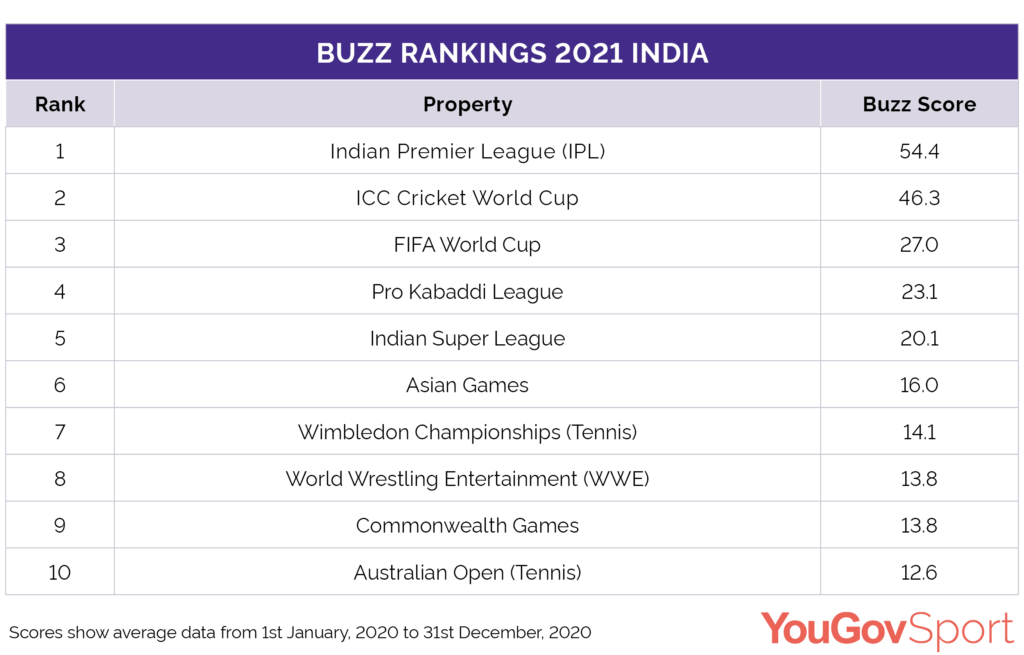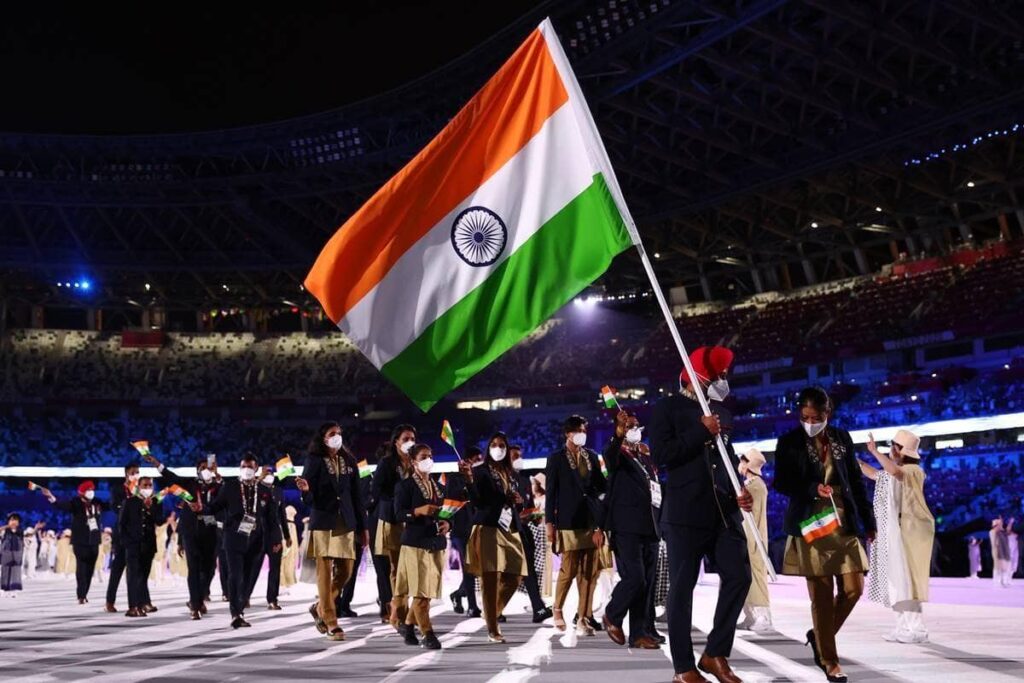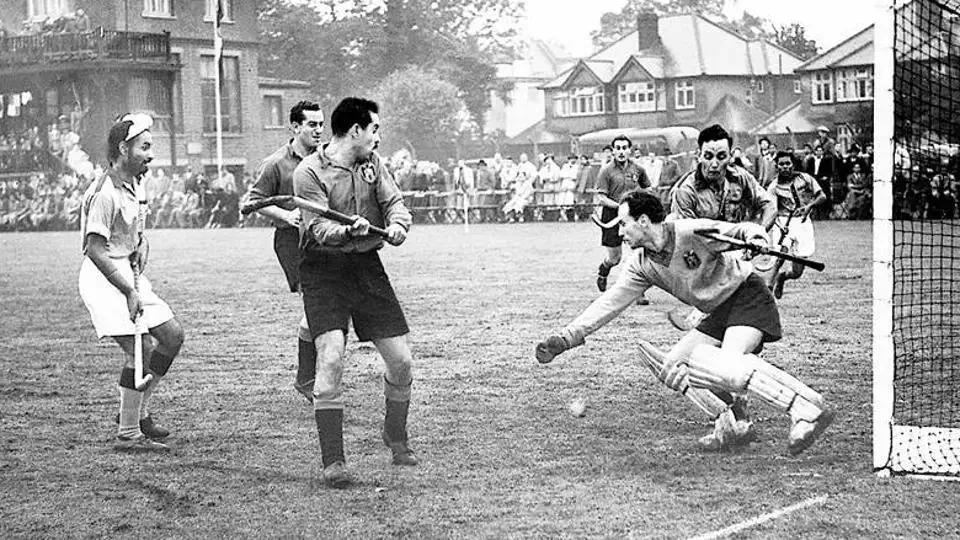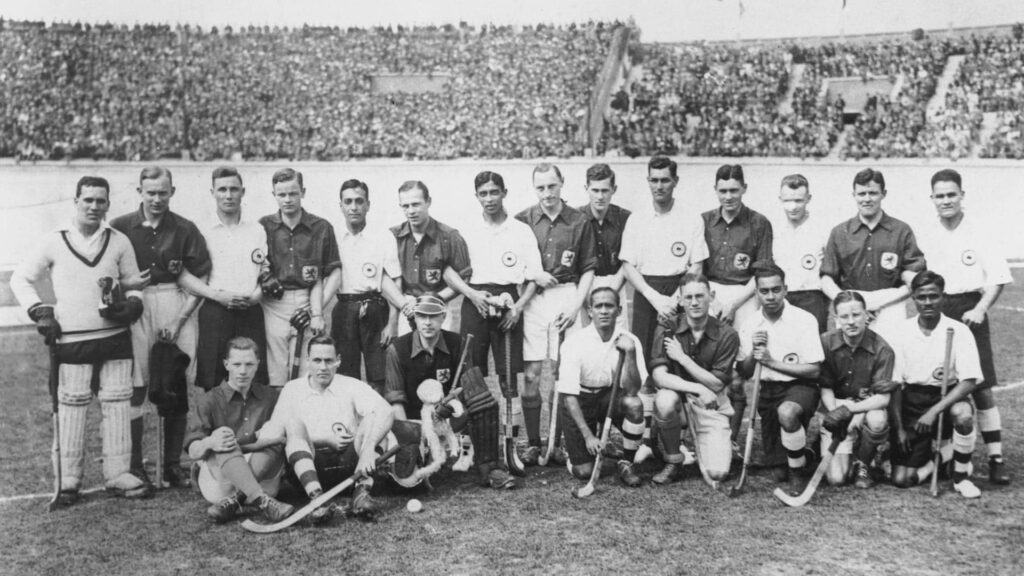Call up your friends, colleagues or family on a Saturday Noon after a ‘long summer week’, and try asking them about their weekend plans. Chances are that they’ll probably reply somewhere along the lines of,
“Match dekh raha hun yaar!”
Most of the time, you assume that ‘match’ to be either for cricket or football or kabaddi. To a great degree, that assumption is totally true! The following reports by YouGov India back the same with its buzz score rankings for the last year 2020:

The analysis herein shows the positive perception towards a respective tournament compared against any negative attitude for it, thus concluding at the final Sports Index.
Basically, popularity! Clearly, the IPL and the ICC World Cup have been the most favored choices among the most Indian viewers. FIFA and Pro Kabaddi League follow the lead while the India Super League, India’s largest franchise-based football series, arrives next in the list. All the other events including the Asian Games, Commonwealth Games or the National tournaments of other sports do not scale higher than 5th position on the sporting metrics.
To rehash the data above, we can say that cricket, in general, predominantly rules the chart.
It occupies a major pie of the Indian viewership. As it should! It is, by far, the most deserving of the all-time public love it is showered with, the sport being deep-rooted in our country’s rich history, culture and not to forget— ‘sentiments’. It also boosts the economy with its considerable contribution to India’s GDP.
But, the loyalty towards Cricket shouldn’t come at the price of neglecting other distinctive sports that each tournament opportunity has to offer. The bias towards one sport shouldn’t stunt the growth of others.
What the above data also shows, alongside, is the public affinity for sports that are NOT cricket. The National and Local Tournaments for a large section of games, that don’t fit in any of the above stated assumptions, have been missing their audience for a while now. That same impetus that Cricket and the like receives at their friendlies is not received by the rest of the sports even in the most competitive rounds.
India has always been and will stay a cricket-loving nation. Yet in the ever-changing sports landscape, now’s the time to look beyond cricket and give other games a chance.
We, as ‘responsible’ citizens (& die-hard sports buff), have to face this cold fact:
“Olympic Sports are NOT given the same pedestal
as the leading crowned games in India.”
A pedestal in the form of infrastructural facilities, grassroots initiatives, talent nurturing and training, government funding, sportsmen grants, and the most crucial of them all—a widespread community backing right from the bedrock—all have been raised for one segment of sports, yet a whole other segment had been deprived of it for a long time in the past. Sure, love and affection would be all but showered when the major sporting seasons arrive, the galore of tweets and hashtags never slumping down. But that’s not what develops the sport. It’s this pedestal that does.

Now, more than ever, there’s a grave need to address the elephant in the room.
India is known to be a repertoire of the best cricketing talents worldwide, but in midst of all this cricket-fog, she has never really come to be known as a country of overall international sporting success.
Before the onset of the Tokyo Olympics, India stood at a tally of 28 medals spanning from over a century of participation in the Olympics. Right from our first appearance as a team at the 1920 Olympics games, till our last performance at the 2016 Rio Olympics—the prospects of us ranking in any double–digit wins in our halls of fame had only been bleaker with the medal counts of 1s and 0s. We had only ever brought home a gold in an individual sport once, the remaining 8 earned by our hockey team alone way back in the days.
The atmosphere was particularly glum when the contingent had to return home empty-handed 4 times. And while these were the tales from the Summer Games, the medal tally for the Winter Olympics had been woefully non-existent. A void was created in these years when India did not do good at the games, with people trying to ignore it and instead fill the void up with the victories gained in the crowned sports.

Ever wondered what the previous games were like?
Every fourth year, we used to build up those child-like hopes, clinging to the possibility of a certain medallion shrouded in a sheet of metallic lustre—Gold.
Brimmed with expectations and an optimistic breeze all over the nation, we held on to our fleeting dreams from the comforts of the living rooms while our Olympians held on to their potent ones—dreams of the everlasting kind and years of training to depend on out there in the field. Nursing no blind hopes themselves, they kept on reinventing their skills, techniques and efforts, always persevering for a perfection that edged towards the extremities. To conquer that one moment that they could call their victory, that the nation could call its own, the athletes gave all they had— a dedication at its firmest, a sacrifice at its harshest and a performance at its pure finest.
It’s in that moment—that nano-second, that couple of minutes, that hour—when everything else would slow down and fade away, where an opportunity of a lifetime would linger in elapsed time, falling off in a heartbeat. A frame of mind only a few could get into through a ‘trial by fire’. Something our athletes strived to achieve with every practice. Even now, this is the rite of passage for every Olympian out there.
But how far could these have taken our athletes towards glory, when the ground reality of a biased sports culture is being struck beneath their feet. How close could it have brought them towards the gold when a majority of them are actually alone in their quests, an irony against the echoes of loud cheers that ring only in the moment of passing? How would they go down in history when it’s not only an Olympic medal dream that they’re fighting for, but also a wall of resistance rooted deep in the societal mindset that they are fighting against? A wall that prevents us and the system from supporting their disciplines in the ‘true sense’, and not just when there’s a prestigious international medal at stake, that we didn’t even notice existed.
Yet with near saves, near misses and a will that never bends, our sportspersons never let the hopes of the multitudes ebb down. The games kept testing Indian Olympians with their metrics and rankings and scores, and in the face of it all, they still shined and showed unparalleled grit, reaching splendid heights every once in a while. The journey ultimately led to the Indian contingent to give their best comebacks in the Tokyo Olympics—an all-time high medal tally of 7 as of today. Proving time and again, that every effort—a near miss or a highest win—would unite the country together in moments of pride and nationalism.
But what did happen in the past years, when the dreams—both ours and the athletes—had crash-landed from the clouds? We, the ones not on the Olympic altar, had set up the expectations, but what came next when the tally did not measure up to these expectations we projected? Were we quick to judge and critic? Did we outrage and lash out at their shortcomings or did we coo and coax them into a ‘better luck next time’? Or did our hearts too break like theirs, seeping into distraught and mourning, sometimes into recrimination? Or were we left to our antics, wailing and weeping, breaking down into tears of disappointment? Well, it turns out, there was a little bit of it all.
After two weeks and a half, when the applause died down and the stadiums cleared out and the news channels shifted to other high-grossing stories to cover, the social media accolades and tweets regressed back to their normal routine and the celebrations for the decent feats were done with. Within a month, we slipped back into an ‘Olympic Comatose’ of sorts.
It’s a chaotic limbo that many find themselves in, the wins and losses recede to the background, while we feed our minds with a comfort food called cricket. Meanwhile, the schools and colleges would still overlook fitness and sports, the teachers would still take away that one unstructured P.T. period every week to fill in some extra lectures, the parents would still reprimand their kids for wasting time on ‘playing’ and the students would keep giving in to the overbearing pressure of achieving academic goals ‘only’.
Somehow, in the midst of it all, we would nevertheless expect world-class champions to be created overnight. Breaking out from the comatose quadrennially, we’d then cheer and holler and scream our lungs out to support.
On the other hand, there’s never really a moment of rest for our athletes, as they start their routine right back up after each tournament, working relentlessly in silence, a stark contrast to the buzzing crowds they had witnessed on the D-days. Just like a metal that hardens itself under the harsh heat, they’d work towards their next aim.
Yet again, the cycle of the 4-year Olympic priming would begin. For some, the journey has been way longer than that. The pain and the hard-work would then reap the winning glories, a pure bliss embracing them.
Even the defeats would never deter our athletes—dejected maybe, but never ‘deterred’. If anything, they come back stronger than ever in the major tournaments. The sentiment ‘then’ has stayed similar even today, as reflected by the resurging performances of Mirabai Chanu, Lovlina Borgohain, P.V. Sindhu, the Women’s and Men’s Hockey Team and countless others.
The same was reiterated in this twitter thread involving the Prime Minister’s response to Bhavani Devi’s loss in the 2nd match of sabre-fencing, “You gave your best and that is all that counts. Wins and losses are a part of life. India is very proud of your contributions. You are an inspiration for our citizens.”
Even though the emotion stays the same throughout time, something did seem to change this year. A paradigm shift was seen in the arena.
Maybe it was the re-instilled sporting spirit, possibly the immaculate training the Indian Olympians underwent themselves, perhaps the monetary support of our athletes by the public-private partnerships (PPPs), or maybe the state revamp of the previously-rotten sports bureaucracy.
But that’s not all there was to the story.
For all the world knows, it might just be the ‘historic parallels’ that were drawn between these games and the resilient foray of the Indian Contingents into Olympics during the earlier times of Free India.
Let’s dive a little deeper into the love affair with a glance at the past, shall we?

India’s History at the Olympics:
The records may show our first Olympic participation in the year 1900, in Paris wherein the lone marathon athlete Norman Pritchard won 2 medals. But whether it should be credited to India or Britain is actually a matter of dispute, considering the confusion of nationalities and the bygone colonial identity politics.
The real Indian Olympic Journey started from 1928, Amsterdam.
It was the majestic hockey team that led to India’s first ascent to the golden throne. The sport was introduced first in the Indian army, welcomed in love with open arms by the masses, gradually building up to the Indian Hockey Federation’s formation in 1925. The IHF-organised international tours in New Zealand showcased the impeccable feats of the hockey men’s team, where they won 18 matches of the 21 played. These led to the rise of a young Dhyan Chand who would later go on to become the Hockey Wizard, arguably the best hockey player that the world had ever seen.
On the soils of Amsterdam, when the British India team performed for the first time in Olympics, under the captaincy of Jaipal Singh and Eric Pinninger, they were a force to be reckoned with. They played 5 matches in all, scoring 29 goals and conceding none. Of these, Dhyan Chand alone scored 14 of them. This debut cliched them a glimmering gold and thus, a whole legacy was birthed, treasuring 7 more gold medals in the name of India.
1928 was the first time when the victory was ours. The only things amiss were the flag unfurled and the anthem sung that were not our own, but a country that colonized us.
It’s even said that during this game, there were only 3 people who bid them off on their sail to Amsterdam but when they returned back to the Bombay port, crowds in thousands flocked the adjoining Mole Station to welcome them back home. Such was the spark they ignited in the hearts of a million more countrymen for Olympics and Hockey, the years of 1928-1980 witnessing one of the greatest love stories to go down in history.
When the team returned in the famous 1948 games, it was the first time the march was led under the tri-colour instead of the British-India flag. Inspite of the previous unparalleled gold hattrick, ‘this’ was the greatest moment of India—not just because of the immaculate campaign itself but what it represented.
And it represented the materializing of the dreams belonging to generations. The wins represented the shattering of the British-imposed colonization, a freedom yearned for 200 years. On the field, the players were fuelled by the burning rage at our captivity, that had been simmering low for 2 centuries. The hockey legend ‘Balbir Singh’ thrashed the colonizers on their own home ground with a smooth 4-0, once again raking in the gold medal with an underdog pride. The gold was how we evened the scores, how we put a crack in the British armour of fragile self-conceit.
That was the first time when the slow dulcets of the Free India’s National Anthem were heard by the whole world in the Olympics, the tri-coloured flag rising high in the skies. Victory had never tasted sweet before, and truly ours.
And with that the legendary streak run of six gold medals went on till 1956. In these 12 magnificent games, the Hockey Team alone contributed eleven medals to the tally.
Written by- Siddhi Shah
Edited by- Radhika Khandelwal
